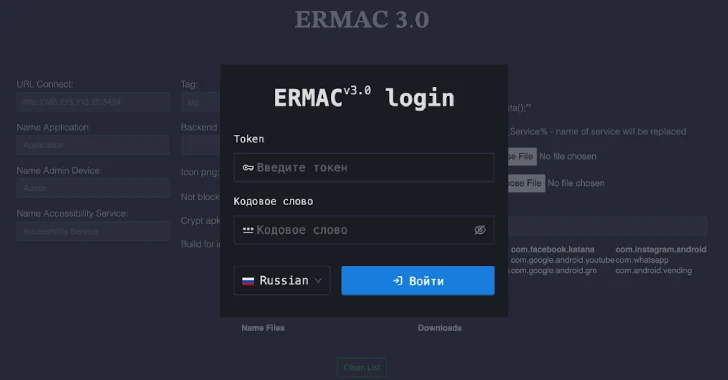In a significant development within the cybersecurity landscape, researchers have obtained and analyzed the complete source code of ERMAC V3.0, an advanced Android banking trojan. This analysis has unveiled critical vulnerabilities within the malware’s infrastructure, providing valuable insights for enhancing defense mechanisms against such threats.
Evolution and Capabilities of ERMAC V3.0
ERMAC, initially identified in September 2021, has undergone substantial evolution. The latest iteration, ERMAC V3.0, has expanded its reach, now targeting over 700 applications spanning banking, shopping, and cryptocurrency sectors. This expansion is facilitated through sophisticated form injection techniques, enabling the malware to overlay legitimate app interfaces and deceive users into divulging sensitive information.
The malware’s lineage traces back to earlier threats like Cerberus and BlackRock, with ERMAC V3.0 representing a significant advancement in both functionality and infrastructure. Notably, it employs AES-CBC encryption for communications between infected devices and command-and-control (C2) servers, enhancing its stealth and resilience against detection.
Dissecting the Malware’s Infrastructure
The leaked source code has provided a rare glimpse into the comprehensive infrastructure of ERMAC V3.0, which comprises several key components:
– Backend C2 Server: Built using PHP and Laravel, this server enables operators to manage compromised devices and access stolen data, including SMS logs and account information.
– Frontend Panel: Developed with React, this interface allows operators to issue commands, manage overlays, and interact with connected devices.
– Exfiltration Server: A Golang-based server responsible for collecting and managing data exfiltrated from infected devices.
– Android Backdoor: An implant written in Kotlin that facilitates control over compromised devices, enabling data collection based on commands from the C2 server.
– ERMAC Builder: A tool designed to assist in configuring and creating builds for malware campaigns, allowing customization of application names, server URLs, and other settings.
This modular architecture underscores the malware’s sophistication and the operators’ commitment to maintaining a robust and adaptable platform.
Identified Vulnerabilities and Security Flaws
The analysis has uncovered several critical security flaws within ERMAC V3.0’s infrastructure:
– Hardcoded Credentials: The presence of hardcoded JWT secrets and static admin bearer tokens poses significant security risks, potentially allowing unauthorized access to the malware’s control panel.
– Default Root Credentials: The use of default root credentials, such as the password changemeplease, further exacerbates the risk of unauthorized access and control over the malware’s infrastructure.
– Open Account Registration: The admin panel’s open account registration feature lacks proper authentication controls, enabling anyone to register administrator accounts through the API without verification.
These vulnerabilities not only expose the malware’s infrastructure to potential hijacking but also provide defenders with opportunities to track, detect, and disrupt active operations.
Implications for Cybersecurity and Defense Strategies
The exposure of ERMAC V3.0’s source code offers a unique opportunity for cybersecurity professionals to understand the inner workings of modern banking trojans. This knowledge is instrumental in developing targeted detection methods and mitigation strategies.
Defenders can leverage this information to:
– Enhance Detection Capabilities: By creating specific signatures and behavioral indicators based on the malware’s code and communication patterns, security teams can improve their ability to identify and respond to infections.
– Strengthen Infrastructure Security: Understanding the malware’s exploitation methods allows organizations to fortify their systems against similar attacks, particularly by addressing common vulnerabilities such as hardcoded credentials and inadequate authentication mechanisms.
– Disrupt Malware Operations: By exploiting the identified security flaws within the malware’s infrastructure, defenders can take proactive measures to disrupt ongoing campaigns and prevent further infections.
Conclusion
The leak of ERMAC V3.0’s source code marks a pivotal moment in the ongoing battle against cyber threats targeting financial institutions and their customers. While the exposure of such sophisticated malware underscores the persistent challenges in cybersecurity, it also equips defenders with the insights necessary to develop more effective countermeasures. By dissecting the malware’s infrastructure and identifying its vulnerabilities, the cybersecurity community can enhance its collective resilience against evolving threats.



